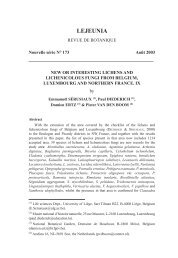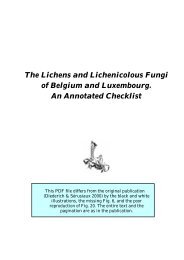A Synopsis of the Genera Skyttea, Llimoniella and - Lichens of ...
A Synopsis of the Genera Skyttea, Llimoniella and - Lichens of ...
A Synopsis of the Genera Skyttea, Llimoniella and - Lichens of ...
You also want an ePaper? Increase the reach of your titles
YUMPU automatically turns print PDFs into web optimized ePapers that Google loves.
472 THE LICHENOLOGIST Vol. 32<br />
Distribution. Austria, Belgium, France, Spain (Navarro-Rosines et al. 1994)<br />
<strong>and</strong> Ukraine (B. J. Coppins, pers. comm.).<br />
Observations. Unguiculariopsis acrocordiae clearly does not belong to<br />
<strong>Skyttea</strong> s. str. It strongly resembles o<strong>the</strong>r species <strong>of</strong> Unguiculariopsis, but<br />
is distinguished by straight, apically not hooked excipular hairs <strong>and</strong> asci with<br />
a thickened apex. However, at least four o<strong>the</strong>r lichenicolous species <strong>of</strong><br />
Unguiculariopsis with straight (not hooked) excipular hairs are known: U.<br />
lesdainii, treated in detail below, U. lobariellum S. Kondr. & D. J. Galloway (see<br />
Kondratyuk & Galloway 1995), U. refractiva (see Coppins 1998), <strong>and</strong> U.<br />
manriquei Etayo (see Etayo & Diederich 1996). The hairs in U. acrocordiae are<br />
quite variable, <strong>and</strong> some have a distinctly swollen base, which is characteristic<br />
for most species <strong>of</strong> Unguiculariopsis.<br />
The structure <strong>of</strong> <strong>the</strong> ascus apex is also, in our opinion, variable in this genus.<br />
In a specimen <strong>of</strong> U. thallophila {Coppins 156), we observed that most asci have<br />
no apical wall thickening when studied in KI, whilst o<strong>the</strong>rs in <strong>the</strong> same<br />
apo<strong>the</strong>cium have a thickened wall, some with an indistinct internal ocular<br />
chamber. In U. acrocordiae, <strong>the</strong> wall is generally thicker at <strong>the</strong> apex, with<br />
sometimes an ocular chamber visible.<br />
A strong argument to consider U. acrocordiae, U. lesdainii, U. lettaui, U.<br />
thallophila <strong>and</strong> U. refractiva as congeneric is <strong>the</strong> presence <strong>of</strong> <strong>the</strong> same excipular<br />
pigment, which is orange brown, when observed in water, becomes darker<br />
reddish to purplish in K, <strong>and</strong> N — (or more bright orange).<br />
For all <strong>the</strong>se reasons we are convinced that U. acrocordiae belongs to<br />
Unguiculariopsis s. str. Unguiculariopsis acrocordiae is a minuscule, but very<br />
distinct species with reddish, ± applanate apo<strong>the</strong>cia <strong>and</strong> a hairy margin,<br />
confined to Acrocordia gemmata. It can hardly be confused with any o<strong>the</strong>r<br />
lichenicolous fungus, <strong>and</strong> it is <strong>the</strong> only known fungus growing on A gemmata.<br />
Additional specimens examined. Austria: Burgenl<strong>and</strong>: Siidburgenl<strong>and</strong>, Giinser Gebirge, im engen<br />
Taleinschnitt zwischen Markt Neuhodis und Althodis, 380 m, 1991, Hafellner 31378 (GZU);<br />
Sudburgenl<strong>and</strong>, Tal des Rodlingerbaches S von Tschaterberg, c. 1 km NW vom Stausee, 250 m,<br />
1992, Hafellner 29329 (GZU); Tobaj N von Giissing, S-exponierte Hange des Tobajer Berges,<br />
250 m, 1990, Hafellner 24958 (GZU).—France: Orne: S. loc, s. d., Olivier Lich. exs. 245 (as<br />
' Verrucaria gemmata') (LUX).<br />
Unguiculariopsis groenl<strong>and</strong>iae (Alstrup & D. Hawksw.) Etayo &<br />
Diederich comb, nov.<br />
Geltingia groenl<strong>and</strong>iae Alstrup & D. Hawksw., Meddr Grenl<strong>and</strong>, Biosci. 31: 33 (1990).—<strong>Llimoniella</strong><br />
groenl<strong>and</strong>iae (Alstrup & D. Hawksw.) Triebel & Hafellner, in Kiimmerling et al., Bibl. Lichenol. 53:<br />
156 (1993); type: Greenl<strong>and</strong>, Narssaq d., 1 km S <strong>of</strong> Qagssiarssuk, 61°8'N, 45°32'W, alt. 140 m,<br />
on Caloplaca citrina s. 1., 1980, Alstrup 801120 (C—holotype, vid.).<br />
(Fig. 16A & B)<br />
For a description <strong>and</strong> additional illustrations, see Alstrup & Hawksworth<br />
(1990).<br />
Hosts. Commensalistic on Caloplaca citrina s. lat., Fulgensia bracteata <strong>and</strong><br />
F. fulgens (thallus). An additional specimen <strong>of</strong> U. groenl<strong>and</strong>iae, mentioned by





